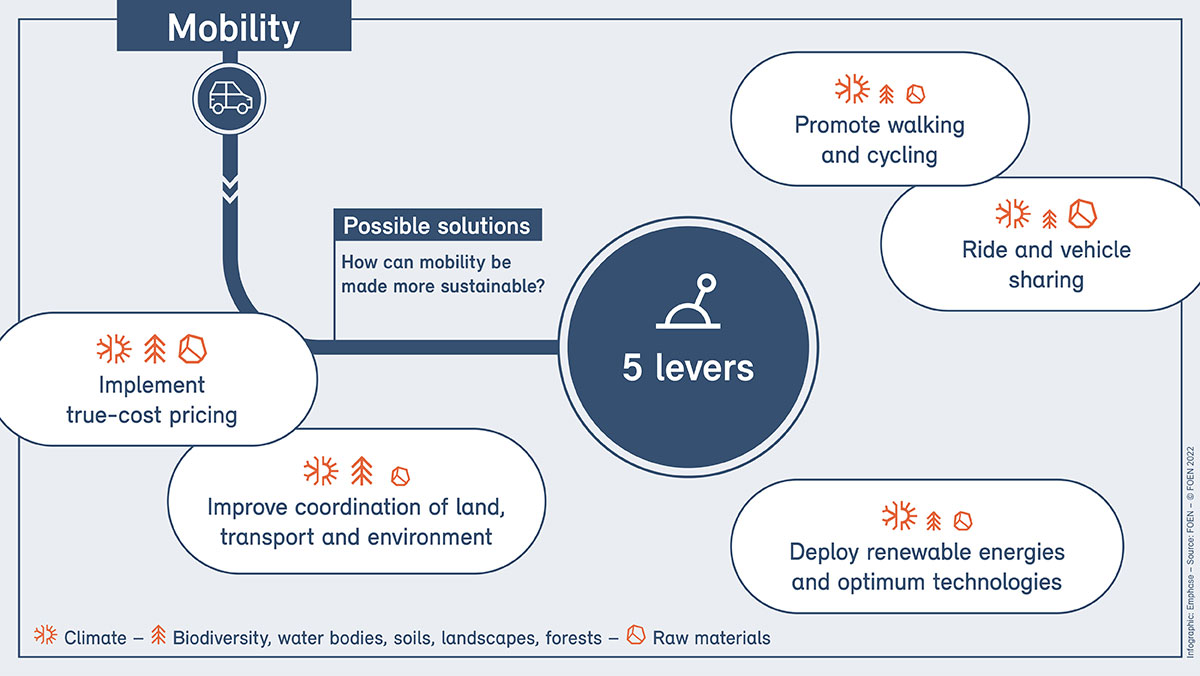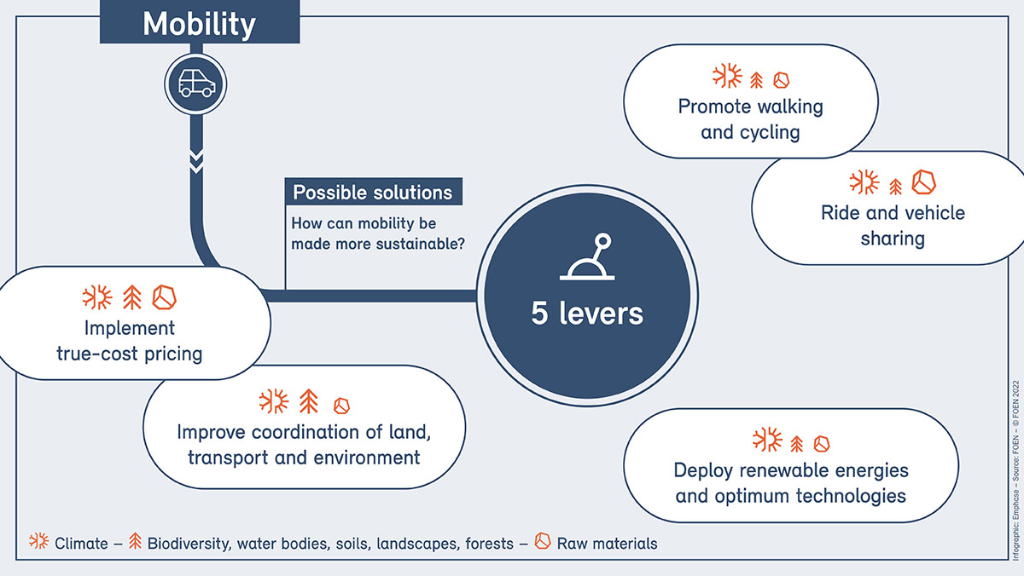Mobility is after nutrition and housing one of the areas of consumption and production with the greatest effects on the environment. A variety of levers and approaches can be used to make mobility more resource efficient and sustainable. There are significant opportunities to make transport more environmentally sustainable through the promotion of walking and cycling, shared and multi-modal mobility, improved coordination of space and transport, and eco-friendly mobility technologies based on renewable energies.
Promote walking and cycling
Walking and cycling is good for people’s health and for the environment. With 46% of car journeys covering less than five kilometres, these are an ideal distance to be cycled instead. Therefore, particularly in towns and agglomerations, short journeys by car could be replaced by bicycle journeys.
Crucial to exploiting this potential, however, is safer and more attractive infrastructure. The Cycle Path Act is intended to lay an important foundation for coherent and safer cycle lanes.
- Implement the law on cycle, foot and hiking paths
- Make more use of parking guidance systems to manage traffic
- Conserve attractive open and green spaces and water bodies in urban areas, or create new ones to shorten leisure journeys
- Multifunctional use of transport infrastructures in residential areas (e.g. infrastructure spaces used at different times as play spaces, markets, meeting points and transport)
- Interconnect health and mobility strategies
- Promote mobility management in communes and companies in favour of walking and cycling
- Support awareness-raising programmes for more sustainable leisure traffic
- Promote cycling instruction in schools
- Encourage proximity of home & work, e.g. neighbourhood co-working spaces or working from home
- Statutory frameworks / federal government strategies
- Transport and spatial planning / infrastructures
- Financial and tax incentives
- Funding programmes
- Public sector as role model
- Transparency / product information
- Cooperation / dialogue
- Training / awareness-raising
- Innovation / research / pilot projects
- New business models
Implement true-cost pricing
In order to respect the polluter pays principle, which is enshrined in the Environmental Protection Act (EPA), and to reduce ecological disincentives, the external costs – caused for example by air pollution, noise and CO2 – should be better incorporated in the pricing of all mobility offerings.
An example of this is the heavy goods vehicle charge (HGVC), a central pillar of the federal government's policy of transferring freight from road to rail. It is part of a modern freight traffic policy, which implements the principle of cost-reflective pricing in the field of heavy goods transport and has played an important part in improving air quality along road axes, including along the trans-Alpine corridors. At the same time, it has increased the efficiency of road transport.
- Users of mobility services increasingly themselves bear the internal and external costs they generate
- Reduce environmental impact by differentiating prices according to ecological criteria (e.g. heavy goods vehicle charge (HGVC) for road traffic)
- Distance-related pricing differentiated according to location and time
- Exempt electric and hydrogenfuelled HGVs from the HGVC
- Cancel tax breaks for diesel public transport buses
- Statutory frameworks / federal government strategies
- Transport and spatial planning / infrastructures
- Financial and tax incentives
- Funding programmes
- Public sector as role model
- Transparency / product information
- Cooperation / dialogue
- Training / awareness-raising
- Innovation / research / pilot projects
- New business models
Improve coordination of space, transport and environment
Enhanced coordination of spatial and transport planning also promise to have a positive impact on the environment and health. For example, journeys and distances covered could be reduced through compact settlement centres in which all key everyday needs can be met . The revised Spatial Planning Act lays the foundations for this sort of inward urban development.
New working models, for example with working from home arrangements or co-working spaces, can also play an important part here and in any case contribute to a reduction in travel to and from workplaces.
Furthermore, infrastructure expansion can be better integrated into the open countryside and settlements if environmental concerns are taken into account, as this improves landscape quality, minimises urban sprawl, and reduces soil use, habitat fragmentation and resource consumption. This is where the revised sectoral plan for transport, programme section 'mobility and space 2050', comes into play.
- Cancel parking space requirements
- EIA: Include environmental perspective at planning and programme stage; do not wait until construction project in progress
- Factor environmental strategies (e.g. climate, soil, biodiversity) into draft infrastructure sectoral plans and strategic development programmes for national highways and railway infrastructures
- Transport infrastructure: Switch from demand to supply-based strategy
- Bundle infrastructures (e.g. roads and power lines)
- Fit roads with digital infrastructure to optimise capacity utilisation, and avoid building new or widening existing roads
- Use transport hubs to help relieve the strain on the environment
- Agglomeration programmes (incl. avoiding environmental impacts, inward urban development, short journeys)
- Promote night trains and shifting long-distance international passenger traffic to railways
- Funding programme to replicate good practice
- Encourage participation: Forward-looking planning and discussion of basic values, including all mobility, environment and spatial planning actors
- Statutory frameworks / federal government strategies
- Transport and spatial planning / infrastructures
- Financial and tax incentives
- Funding programmes
- Public sector as role model
- Transparency / product information
- Cooperation / dialogue
- Training / awareness-raising
- Innovation / research / pilot projects
- New business models
Ride and vehicle sharing and interconnect infrastructures and mobility offerings
The capacity utilisation of individual vehicles is generally very low: for example, in commuter traffic, the average occupancy rate of passenger cars is 1.1 persons. Public transport is only fully occupied at peak times.
The promotion of carpooling can help improve this situation in road traffic. If drivers share a ride, they take up less space on the road.
The networking of mobility data as an inter-modal approach can reduce the environmental impact and increase resource and energy efficiency in transport by better utilising the available capacities of infrastructure and mobility offerings (public transport, private and hire cars, bikes, etc.). The prerequisite for this is a better information flow between infrastructure operators, mobility providers, intermediaries and end customers.
But the different modes of transport not only need to be digitally connected, they also have to be physically connected. This is what the federal government, cantons, cities and communes are supporting in the 'transport hubs programme'. Better transport networks lays the foundation for an increasing number of people to be willing to do without their own car.
- Create carpool lanes for rideshares (lanes reserved for cars with multiple occupants)
- Preferential treatment for carsharing (sharing a car locally, e.g. for outward journeys by public transport) and ride-sharing (outward journeys with cars with multiple occupants) in tourist locations
- Preferential treatment for ride-shares in employer car parks; encourage carpooling
- Establish a mobility data infrastructure for a green and efficient mobility system
- Digitalisation, provision and exchange of mobility-relevant data, especially with a view to replacing motorised private transport with non-motorised transport, car and ride-sharing, and taxis
- Promote city, commune and canton pilot projects on multimodal mobility
- Statutory frameworks / federal government strategies
- Transport and spatial planning / infrastructures
- Financial and tax incentives
- Funding programmes
- Public sector as role model
- Transparency / product information
- Cooperation / dialogue
- Training / awareness-raising
- Innovation / research / pilot projects
- New business models
Deploy renewable energies and optimum technologies
Environmental impacts are primarily to be reduced directly at source. In terms of road traffic noise, for example, this can be achieved through low-noise road surfaces, low-noise tyres and speed limit reductions. Meanwhile, measures and regulations on exhaust emissions and fuel quality reduce the emission of pollutants.
Furthermore, transport emits large quantities of the greenhouse gas carbon dioxide (CO2). To achieve the net zero emissions target by 2050, a shift away from fossil fuels is needed. A key path to achieving this is electromobility, which includes battery-powered vehicles and fuel cell vehicles. Synthetic fuels could also play a supplementary role.
However, in order for journeys with these vehicles to be as environmentally friendly as possible, it is important that the energy used to charge the batteries and to manufacture alternative fuels and the vehicles themselves comes from renewable sources.
The recycling of electric car batteries also needs to be further developed.
But it is not only road transport that emits large amounts of greenhouse gases, aviation does too. Long-haul flights of over 1,500km account for around 80% of emissions. Within mainland Europe, journeys should be made by train where possible to protect the environment. Even better, however, is to reduce the distances travelled for leisure trips and to increasingly replace business travel with video conferencing. In addition, the promotion of synthetic aviation fuels can help reduce emissions.
- Toughen CO2 targets for new vehicles in line with EU
- Vehicle emissions regulations (European standards)
- Continue carbon offset requirement for fuel importers
- Implement requirements for sustainable aviation fuel content in line with EU
- Use low-noise tyres and lay lownoise road surfaces
- Promote charging infrastructure for electromobility
- Develop green financing models for transport infrastructure
- Promote renewable synthetic aviation fuels
- Encourage electric and hydrogen-powered buses and boats for public transport
- Monitor climate and environmental impact of renewables and rebound effects of new technologies
- Push vehicle downsizing
- Promote use of renewable energies
- Encourage development of green drive technologies
- Develop measures to reduce brake, road and tyre wear
- Statutory frameworks / federal government strategies
- Transport and spatial planning / infrastructures
- Financial and tax incentives
- Funding programmes
- Public sector as role model
- Transparency / product information
- Cooperation / dialogue
- Training / awareness-raising
- Innovation / research / pilot projects
- New business models
Further information
Last modification 16.12.2022








